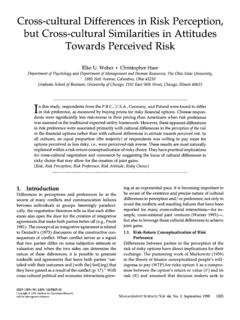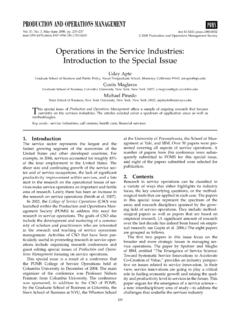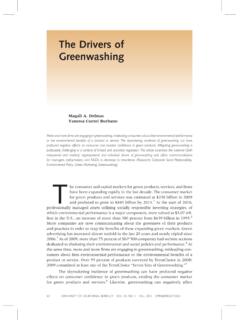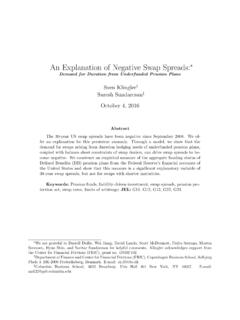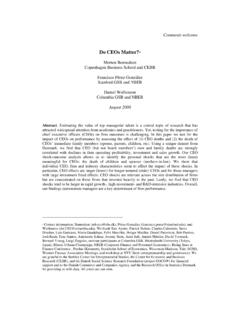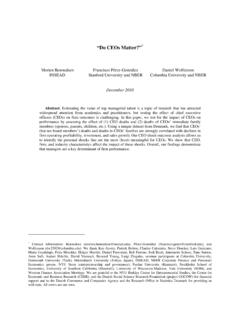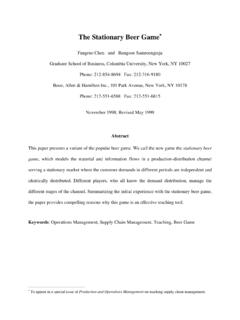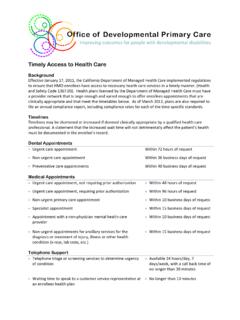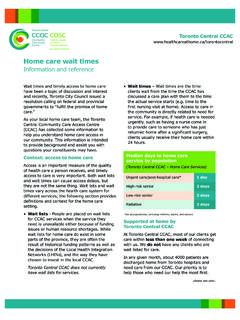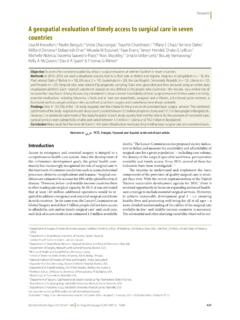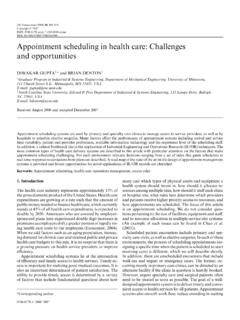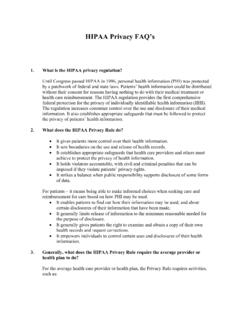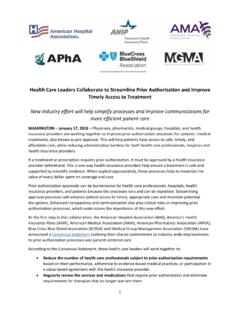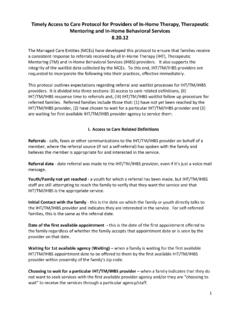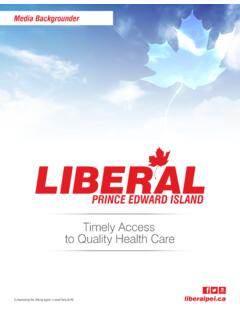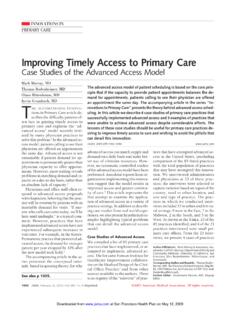Transcription of Providing Timely Access to Medical Care: a Queueing Model
1 Providing Timely Access to Medical care : a QueueingModelLinda V. Green, Sergei SavinGraduate School of Business, Columbia UniversityAbstractMany primary care offices and other Medical practices regularly experience longbacklogs for appointments. These backlogs are exacerbated by a significant level oflast minute cancellations or no-shows which have the effect of wasting capacity. Inthis paper, we conceptualize such an appointment system as a single server queueingsystem in which customers who are about to enter service have a state-dependentprobability of not being served and may rejoin the queue. We derive stationarydistributions of the queue size assuming both deterministic as well as exponentialservice times and compare the performance metrics to the results of a simulationof the appointment system. Our results demonstrate the usefulness of the queueingmodels in Providing guidance on identifying patient panel sizes for Medical practicesthat are trying to implement a policy of advanced Access .
2 1 Introduction and Literature ReviewDifficulty in getting a Timely appointment to see a physician is a very common a recent study, 33% of patients cited inability to get an appointment soon as asignificant obstacle to care (Strunk and Cunningham 2002), and the Institute of Medicine2001 report identified timeliness as 1 of the 6 key aims for improvement in its majorreport on quality of health care . For most patients, their primary care physician is theirmajor Access point into the health care system. Yet primary care practices often havelong waits for appointments and may have difficulty in accommodating patients who havepotentially urgent problems. As a result, patients experience delays in treatment and maybe seen by someone other than their own physician, potentially leading to adverse clinicalconsequences, patient dissatisfaction, and loss of revenue for the practice.
3 Large backlogsmay require additional staffand resources to deal with patients trying to get appointmentsfor the same day, and are often correlated with a high rate of cancellations or patients create a paradoxical situation where a physician is under-utilized whilepatients have long waits in getting appointments. There is a growing body of evidenceindicating that no-shows are associated with substantialfinancial costs to primary careoffices. Pesataet al.(1999) estimated a loss of over a million dollars resulting from 14,000of missed appointments in a pediatric practice. Mooreet al.(2001) looked at a familyclinic where 31% of the appointments were missed or canceled and estimated that thecorresponding loss was between 3% and 14% of annual have been a variety of approaches for reducing no-show rates: sending pre-appointment reminders; usingfinancial penalties; and Providing services to make it easierfor patients to keep an appointment such as transportation vouchers and free or low-cost childcare (Tusoet al.)
4 1999, Pesataet al. 1999). In recent years, a completelydifferent approach to remedying the no-show problem is being adopted by a growing1number of primary care practices. This approach, known as advanced Access , focuseson the inefficiencies built into many existing patient scheduling systems. As opposed toa traditional system where each physician s daily schedule is fully booked in advance,or a carve-out Model in which afixed number of appointment slots are held open forurgent cases, the goal of the advanced Access approach is to reduce delays by offeringevery patient a same-day appointment, regardless of the urgency of the problem. Thefundamental idea behind advanced Access is to do all of today s work today , so thatpatients do not have to wait for appointments, practices do not waste capacity holdingappointments in anticipation of same-day needs, and patients have a greater likelihood ofseeing their own physician.
5 Several success stories have documented the benefits of thisapproach in both managed care and fee-for-service environments including dramaticallyshorter waits, higher levels of continuity of care , less wasted capacity for the practice, andincreased patient, staff, and physician satisfaction (Murray and Tantau 2000).The ability to offer patients Timely care , whether that means same day or withina couple of days, requires some minimum physician capacity relative to patient advocates of advanced Access stressthat demand and supply must be in balance ,they do not offer any means for physicians to identify an appropriate balance for theirpractice. In discussions with practitioners, we have found that one of the central questionsin trying to implement an advanced Access type of system is: What is a manageable panel size? Primary care practices and many specialty care practices, such as cardiology,havea patientpanel asetofpatientswhoreceivetheircarefromthe practiceonsomeregular basis.
6 So in these practices the primary lever to bring demand and supply into arelationship that is compatible with being able to offer short appointment dates is patientpanel order to identify a panel size that will result in short waits for appointments withhigh probability, it is necessary to explicitlyconsider the impact of cancellations. Though2some patients cancel their appointments farenough in advance of their scheduled time toallow for a new appointment request to be substituted, many practices experience a highlevel of patients who cancel too late for this to happen or who simply do not show up at thescheduled time. In this paper, we will refer to both of these patient types as no-shows .Empirical evidence shows that the rate of no-shows increases with increasing appointmentbacklogs (Galucciet ), resulting in more unused appointment slots and wastedphysician time.
7 Therefore, instead of increased patient demand rate resulting in higherphysician utilization, it may actually result inlower utilization levels. In addition, thoughsome patients fail to appear at the appointed time because the original reason for thevisit no longer exists, other no-shows are due to personal or work-related problems or thepatient s decision to seek treatment elsewhere rather than wait. In the latter situations,many no-shows schedule a new appointment with their original physician. This is eventrue when they have sought treatment elsewhere since it is common practice for clinicsand emergency rooms to advise the patient to see their own physician as order to better understand the dynamics of such appointment systems, evaluatetrade-offs, and provide guidance to identify panel sizes that are consistent with shortpatient backlogs and hence advanced Access type of approaches, we develop two queueingmodels that explicitly capture the phenomenon of no-shows.
8 Though a Queueing modelis an approximation of the actual dynamics, we show that the models can be used toprovide reliable guidance on panel sizes thatare consistent with advanced Access . Despitethe fact that about 2/3 of all primary care physicians work in group practices (NationalAmbulatory Medical care Survey 2002), there are a number of studies that document thebenefits of continuity of care (see Smoller 1992). These observations support the viewthat a patient should be seen, whenever possible, by his/her physician, and therefore, thata panel should be associated with an individual physician. Therefore, we conceptualizethe appointment system as a single-server queue in which the probability of a no-show is3a non-decreasing function of the size of the backlog at the time of a patient s request foran appointment (arrival to the system). If a patient is a no-show, he/she remains in queueuntil the time at which service would have begun and the server begins an idle period foran interval of time equal to what would have been the service time.
9 We assume that agiven fraction of no-shows will reschedule after missing the appointment and so instead ofleaving the system after the scheduled (but missed) service time, these patients join theend of the queue. Our Model assumes that patients requests for appointments follow aPoisson process. This is reasonable given therandom nature of these requests and in factthe Poisson assumption has been used in other studies of outpatient appointment systems(see, , Brahimi and Worthington 1991).Because appointment slots are generallyfixedand physicians strive to see a given number of patients per day, our primary Model assumesdeterministic service times. Under this assumption, we derive a recursion that can beused to efficiently compute performance measures such as the expected patient backlogand the probability of getting a same-day appointment. We demonstrate the reliability ofthese results by comparing them to those obtained from a simulation Model of the patientappointment and backlog process which includes factors excluded from the Queueing there is reason to believe that both of these models may underestimate totalsystem variability and therefore result in overestimates of desirable panel sizes, we alsoconsider the identical Queueing Model exponential service times for which wecan derive closed-form expressions.
10 Our results indicate that for parameter values thatare typical of many primary care practices, the two Queueing models are very reliable inidentifying a feasible range of panel sizes compatible with an advanced Access work is related to several distinct literature is a set of papers on appointment scheduling practices, including those inhealth care settings. Mondschein and Weintraub (2003), Cayirli and Veral (2003) andDenton and Gupta (2003) provide comprehensive reviews of this literature. Most of the4papers dealing with health care appointmentsarefocusedoneithertheminimiz ationofreal-time, in-office patient delays or on the minimization of costs/maximization of profitsfor a primary care facility. An important subset of the appointment scheduling literatureis comprised of papers focused on the optimal allocation of service capacity between dif-ferent classes of patients, urgent vs.
